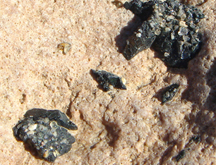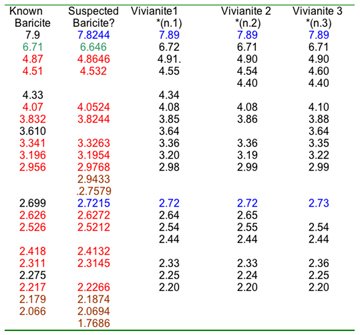
|
||||||
|
|
||||||
|
|
|
Baricite found at Nonconnah Creek location
I showed them to Idajean, and she thought that they were interesting. So, she showed them to Bill Pryor, an Arkansas state geologist and the speaker for the night at the end of the meeting. He spent a little time analyzing them with his magnifying glass and said that they were probable crystals known as vivianite. He asked for permission to take them back to his lab in Arkansas and examine them with other geologists with works. After a couple of weeks he sent them back to me with a short note confirming them to be vivianite. I had never heard of vivianite, but his confirmation started a fire under me. I got on the internet and looked up vivianite. I called and corresponded with Tennessee state geologists, and one of them indicated that there were only two previous occurrences of vivianite in Tennessee. One location didn't exist anymore, and the other location had not been recorded.
I then went to The University of Memphis and met with Dr.
George Swihart of the geology department. He is the professor
in the department that is most interested in minerals, and he
was interested in the crystals I showed him. He asked if he
could have them to study, and I agreed. In a short time, he
called me in and asked me if I would He sent me to the chemistry library, and the earthquake center, where the geology library is located to do some guided research. I have done so, and shared my finding with him. At present baricite has been found in these locations: The Yukon in Canada, New Zealand, and Russia. If what I found is baricite, that will be exciting, because it will be the first occurrence reported in the United States. If it is a new mineral, that will be even more exciting, because I will have the honor of giving it a name. I have decided upon a name, but that must wait. It may be a short time before I find out for sure what I have discovered. If you are interested I will let you know when I get a definitive answer from Dr Swihart. No matter what it ends up being, I owe a great deal to the encouragement I have gotten from Mike and Sherri Baldwin, Idajean Jordan, and many others in the Memphis Archaeological and Geological Society.
This is a page showing the data I obtained from the research
study that I did with the information that he had obtained on
one of my samples at the University of Memphis Physics Dept. I
shared it withhim today (November 15) and he was very pleased
with it. As I mentioned above, he is going to test one more
sample, to see if it will be any different from the first. If
it is determined to be baricite then he will advise me as to
how to write a report making a
X-ray powder data for baricite and three confirmed vivianite samples from the article "X-ray diffraction studies of vivianite, metavivianite, and baricite" by T. Sameshima, et.al. in Mineralogical Magazine, March 1985, Vol. 49 p.82 compared to a recently discovered crystal found at Nonconnah Creek in Memphis, Tn. Tentatively identified as Baricite
Vivianite 1. Earthy, cryptocrystalline vivianite, Waiotu, New
Zealand. Au:2473 Note. The colors above have the following significance: Red shows when the suspected baricite resembles the known barciite more that vivianite; Blue shows when the suspected baricite resembles vivianite more that the known baricite; Green shows when no marked resemblence exists to either one over the other; brown is used when no figures are given for both the known baricite and the vivianite samples to which the suspected baricite can be compared. This article was written by MAGS member, Marvin Nutt, November 16, 2006. Photo of one of Marvin's specimens taken by Mike Baldwin.
|
||||
|
|
||||||

